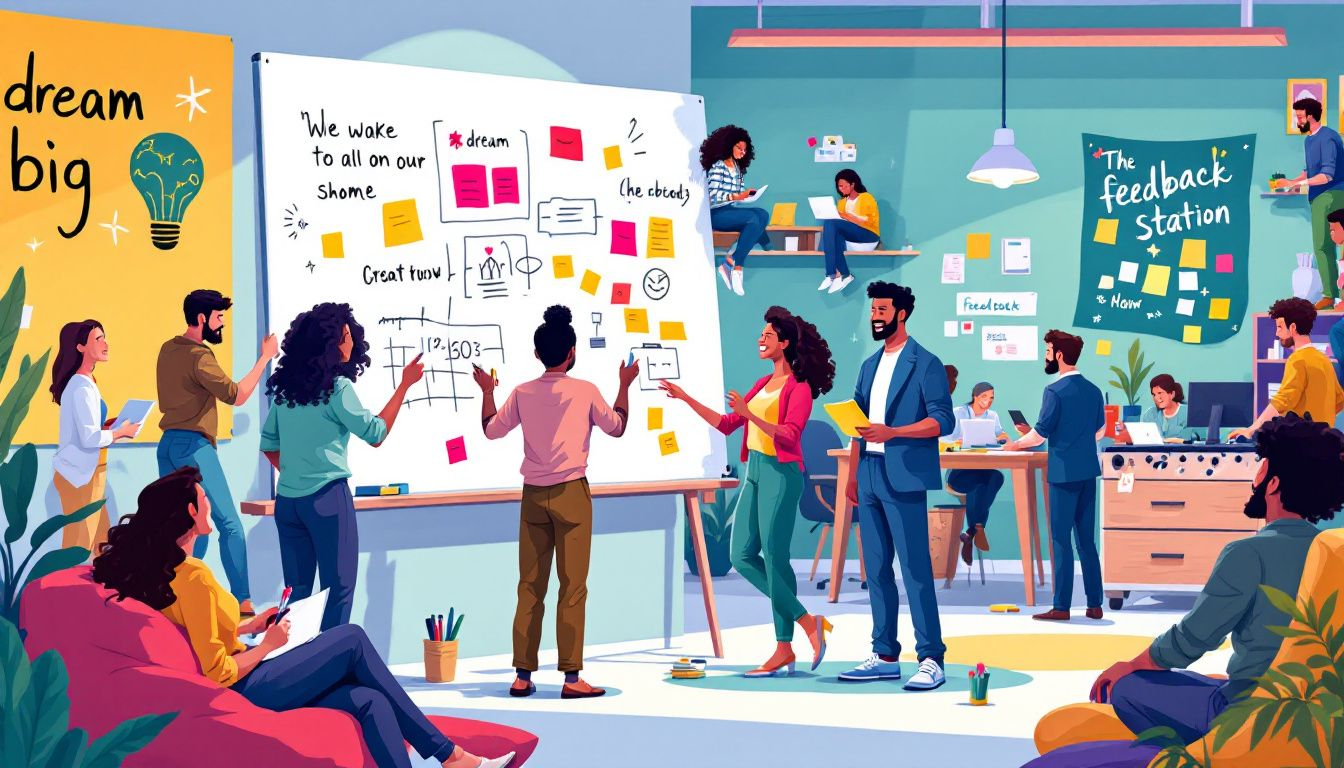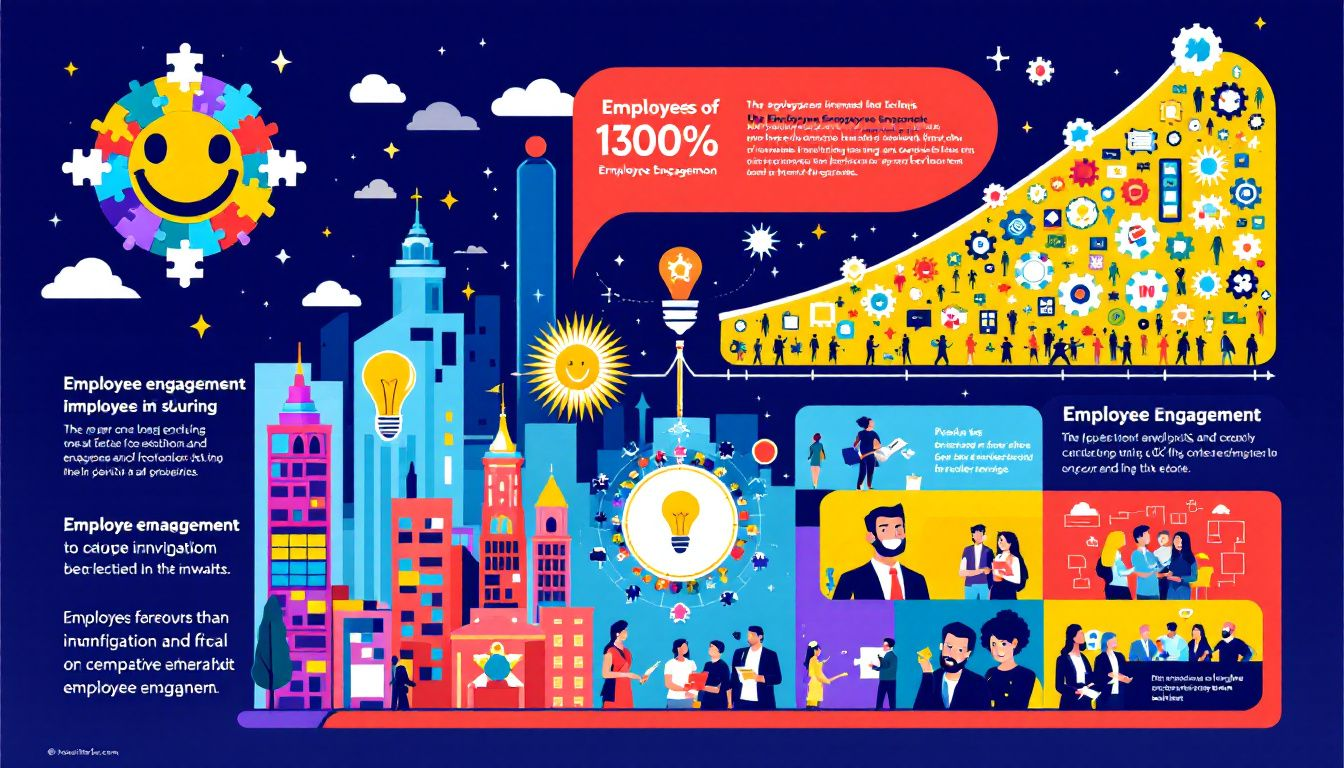Employee engagement directly impacts productivity and retention. Engaged employees are more invested in their work and contribute to the organization’s success. In this article, we’ll explore effective strategies to boost employee engagement and achieve better business outcomes.
Key Takeaways
- Employee engagement is crucial for organizational success, leading to increased productivity, profitability, and employee retention.
- Key drivers of engagement include effective leadership, career development opportunities, and a supportive workplace environment.
- Utilizing technology and analytics can enhance employee engagement by facilitating communication, feedback, and recognition opportunities.
Understanding Employee Engagement

Employee engagement refers to the complete employee journey, from recruitment to recognition and career development. It’s more than just job satisfaction; it’s the emotional commitment employees have towards their organization and its goals. Engaged employees are more productive, committed, and dedicated to their work, which in turn positively impacts overall productivity and business outcomes.
Highly engaged employees hold very favorable opinions about their workplace, contributing to a positive environment. They care deeply about their jobs and customers, fostering innovation and service excellence. When employees are engaged, they bring their best selves to work, creating a ripple effect that enhances team dynamics and organizational success. This connection is crucial because, without team engagement, individual efforts may not translate into collective success.
Boosting employee engagement improves business outcomes and enhances organizational success. Organizations with highly engaged teams often see greater profitability and employee retention, as well as higher customer satisfaction. Employee engagement is a vital focus for any organization aiming to thrive in today’s competitive landscape due to its undeniable benefits.
Key Drivers of Employee Engagement

Recognizing the key drivers of employee engagement helps in developing effective strategies. High-quality leadership, career development opportunities, and a supportive workplace environment are among the top factors that influence engagement levels.
We will examine how these elements foster an engaged workforce.
Leadership and Trust
Leadership acts as the primary driver for promoting an engaged culture within an organization. Effective leadership fosters trust and open communication, which are critical for engaging employees. Active participation by leaders in engagement initiatives sets the tone for the entire organization, encouraging employees to follow suit.
Insufficient involvement from leaders can create a ripple effect, negatively impacting engagement across the organization. When executives do not actively back employee engagement initiatives, these efforts often fail to take hold within the organization. Clear, personalized communication cultivates work relationships and significantly enhances employee engagement outcomes.
Teaching critical soft skills can enhance managers’ effectiveness in driving engagement. Leadership that values employees and shows integrity boosts engagement, reinforcing the need for leaders to be proactive. Prioritizing these aspects helps create an environment where employees feel valued and motivated to contribute their best efforts.
Career Development Opportunities
Professional growth opportunities significantly boost employee engagement. Employees are more engaged and committed when they see a clear path for career advancement. Organizations that provide tailored career programs, like Phillips 66, which developed initiatives to accommodate diverse schedules, enhance engagement by connecting work to employees’ personal values.
It’s crucial to match talent to roles that provide engaging aspects. Organizational leaders and HR teams should work together to ensure that employees are placed in positions where they can thrive and grow.
Investing in career development opportunities fosters a sense of purpose and belonging, leading to increased engagement and job satisfaction.
Workplace Environment
Employees who perceive their workplace as inclusive and supportive are more likely to be engaged. An inclusive workplace environment boosts employee morale and engagement. Research indicates that inclusive workplaces contribute to higher employee satisfaction and lower turnover rates.
A culture of inclusivity enhances collaboration and innovation, improving overall company performance. When employees feel safe and valued, they are more likely to contribute their best efforts and stay committed to the organization’s success.
Prioritizing a supportive workplace environment drives employee engagement and fosters a thriving work culture.
Measuring Employee Engagement

Measuring employee engagement helps understand influencing factors and identify areas for improvement. Effective measurement relies on both survey and non-survey methods to achieve a comprehensive understanding.
We will explore various tools and methods used to measure employee engagement through an employee engagement survey questions.
Employee Engagement Surveys
Employee engagement surveys accurately measure engagement levels. Simplicity and intuitiveness in survey structure ensure that respondents can easily understand and complete the survey. Questions scientifically proven to measure engagement enhance the survey’s effectiveness.
Pulse surveys, which are short and focused, collect ongoing feedback on various topics, complementing annual engagement surveys. Tailoring surveys for different audiences addresses specific needs and perspectives across organizational levels.
Combining various question types, such as open-ended and multiple-choice options, enhances insight collection while keeping respondent engagement high.
Analyzing Survey Data
Integrating operational and experience data provides a comprehensive understanding of employee experience. Benchmarks help organizations gain a competitive edge by evaluating data. Employee engagement benchmarks provide context to survey data and help determine if actions are needed.
Driver analysis helps understand engagement trends and identify key drivers affecting employee engagement. Focusing on high impact/low scoring drivers allows organizations to identify areas that can significantly enhance engagement. Successful engagement programs simplify complex data analysis and highlight vital drivers of engagement.
Continuous Feedback Loops
Managers play a crucial role in day-to-day employee engagement, and listening to employee feedback creates a proactive and aligned workforce. Implementing a structured feedback loop model ensures sustained improvements in employee engagement. Regularly tracking trends in engagement levels and communicating survey results transparently fosters trust and encourages further participation.
Maintaining positive momentum requires acting on feedback, sharing results, and addressing issues identified in surveys. This continuous cycle of feedback and action helps create a culture where employees feel heard and valued, leading to increased engagement and satisfaction.
Strategies to Improve Employee Engagement

A structured approach focusing on key drivers and strategic activities improves the ability to drive employee engagement strategy while increasing employee engagement. We will explore strategies such as fostering open communication, recognizing and rewarding employees, and promoting work-life balance.
Foster Open Communication
Open communication enhances employee involvement, motivation, and trust, aligning employees with business priorities. Effective communication improves business outcomes and empowers employees to stay focused and productive. Transparent communication strategies alleviate fears associated with change and foster a more engaged workforce.
Involving employees in the change process can enhance buy-in and engagement, mitigating pushback against change. Personalized communication fosters a sense of connection and engagement among employees. It also helps them feel valued within the organization.
Digital collaboration tools and analytics help gather direct feedback from employees to inform engagement strategies.
Recognize and Reward Employees
Understanding employees’ desires for challenging tasks, ownership, and development opportunities is crucial for engagement. Offering additional time off and financial incentives are effective ways to reward employees. Employees desire purpose, meaning, recognition of uniqueness, and strong relationships in their work environment.
Tailored career development initiatives substantially improve employee commitment and satisfaction. A positive workplace culture increases employee motivation and reduces turnover. By recognizing and rewarding employees, organizations can create a motivated and engaged workforce.
Promote Work-Life Balance
Supporting work-life balance prevents burnout and maintains high levels of employee engagement. Creating working environments conducive to well-being prevents low productivity among employees. Strategies to promote work-life balance include flexible working hours, remote work options, and wellness programs.
Prioritizing work-life balance ensures that employees remain productive and satisfied. This not only improves engagement but also contributes to overall business success.
The Role of Technology in Employee Engagement

Technology enhances employee engagement by providing tools that facilitate communication, feedback, and recognition.
We will explore the benefits of employee engagement software, the importance of a seamless digital employee experience, and the role of analytics in optimizing engagement strategies.
Employee Engagement Software
The purpose of employee engagement software is to measure, track, and improve employee satisfaction and engagement. Employee engagement platforms offer personalized communication, feedback tools, and data analytics that help engage employees. By offering action items and advice for leaders and managers, this employee engagement platform assists in increasing team engagement and building accountability within teams.
Selecting the right software partner is crucial for successful employee engagement efforts. With the right tools, organizations can streamline feedback processes, improve communication, and offer platforms for employee recognition, significantly boosting engagement.
Digital Employee Experience
A seamless digital experience engages remote and deskless workers, ensuring they feel connected and valued. Platforms like Firstup enhance the employee experience by integrating communication channels and personalizing content. Easy access to information and communication with peers and managers fosters a sense of belonging and engagement.
Effective digital tools can bridge the gap between remote employees and the organization, making them feel integral to the team. Investing in a robust digital employee experience improves engagement levels and ensures all employees feel valued and included.
Leveraging Analytics
Employee engagement analytics help organizations understand the current engagement state and empower action. Data analytics plays a crucial role in optimizing engagement strategies and delivering personalized content to employees. Analyzing engagement trends enables data-driven decisions that enhance employee satisfaction and productivity.
However, many organizations struggle to utilize people analytics effectively, missing out on insights necessary for tailored engagement strategies. Overcoming these challenges is essential for enhancing employee engagement efforts and achieving better business outcomes.
The right analytical tools help identify key drivers of engagement and facilitate targeted actions to improve it.
Case Studies of Successful Employee Engagement Initiatives
Real-world examples provide valuable insights into effective employee engagement strategies. We will explore successful engagement initiatives undertaken by various companies.
These case studies highlight the impact of enhanced communication, personalized development programs, and building a positive culture on employee engagement.
Company A: Enhancing Communication
Nebraska Medicine implemented Firstup’s intelligent communication platform to enhance its engagement efforts. This personalized, multi-channel communication approach significantly improved engagement rates, with some locations experiencing a 15-fold increase.
Grainger also adopted Firstup’s platform to improve accessibility, personalization, and timely communication, resulting in better engagement among its dispersed workforce. Phillips 66 utilized a machine-learning tool for personalized messages, greatly enhancing their employee engagement.
The effective communication strategies adopted by these companies fostered a more engaged and motivated workforce, demonstrating the power of technology in driving engagement.
Company B: Personalized Development Programs
Tailored learning experiences help employees enhance their skills more effectively by aligning with their individual learning styles. Company B leveraged Learning Experience Platforms (LXPs) to meet the varying needs and preferences of a diverse workforce, creating learning paths based on individual interests and career goals. This personalized approach significantly boosted employee engagement and satisfaction.
By using data from personalized learning systems, Company B was able to identify skills gaps and tailor training programs accordingly. Flexible learning environments, such as the ability to learn at one’s own pace, contributed to better engagement and retention of information. These initiatives aligned employees’ career aspirations with organizational goals, resulting in enhanced engagement and productivity.
Company C: Building a Positive Culture
At Phillips 66, the implementation of personalized messaging doubled interaction rates in some locations, reflecting its positive effect on engagement. A positive workplace culture is essential for boosting employee engagement and overall satisfaction. Effective communication strategies are critical in shaping a positive workplace culture.
Fostering a culture that emphasizes clear communication and employee interaction leads to enhanced engagement and productivity. Company C’s focus on creating a supportive and inclusive work environment resulted in a more engaged and motivated workforce, demonstrating the benefits of a positive workplace culture.
Common Challenges in Employee Engagement and How to Overcome Them
Despite the best efforts, organizations often face challenges in maintaining high levels of employee engagement. Common issues are lack of leadership support, ineffective surveys, and resistance to change.
We will explore these challenges and provide strategies to overcome them.
Lack of Leadership Support
Lack of leadership support can severely hinder employee engagement, as it creates a disconnect between staff and management. Organizations should demonstrate the value of engagement initiatives through data and success stories to garner executive buy-in. When leaders actively participate in engagement efforts, it sets a positive example and encourages employees to engage.
Organizations that utilize a high volume of pulse surveys often struggle to act on the findings, which can lead to employee frustration. Ensuring leadership involvement and support creates a cohesive and engaged workforce, driving organizational success.
Ineffective Surveys
Poorly constructed employee surveys can lead to misinterpretation of employee sentiments. Overly complicated survey designs can cause misinterpretation of employee feedback, making it hard to implement changes based on insights. Only 35% of employees believe their organization is effective at post-survey action, indicating a disconnect between collecting data and making real changes.
Finding a software partner for action-oriented surveying is vital to uncover actionable insights for real organizational change. Overuse of pulse surveys often results in rarely taking action on the results, complicating engagement efforts.
Designing effective engagement survey and ensuring follow-up actions improve engagement and employee satisfaction.
Resistance to Change
Resistance to change often arises from fear of the unknown, lack of understanding, or previous negative experiences. Common reasons for employee resistance include feeling threatened in their roles, skepticism about the benefits of the change, and insufficient support from leadership. To overcome resistance, engage employees early in the change process, clearly communicate the benefits of the change, and provide adequate training and resources.
A culture of openness and support fosters resilience and minimizes resistance to change. Involving employees in decision-making and addressing their concerns creates a supportive environment that embraces change and drives engagement.
Summary
Employee engagement is a multifaceted concept that significantly impacts organizational success. Understanding its key drivers, such as leadership, career development, and workplace environment, is essential for developing effective engagement strategies. Measuring engagement through surveys and continuous feedback loops provides valuable insights that guide improvement efforts.
Implementing strategies like fostering open communication, recognizing and rewarding employees, and promoting work-life balance can enhance engagement levels. Technology plays a vital role in facilitating these efforts, offering tools for communication, feedback, and analytics. By learning from successful case studies and addressing common challenges, organizations can create a thriving and engaged workforce.
Frequently Asked Questions
What is employee engagement?
Employee engagement is the emotional commitment that employees feel towards their organization and its goals, which leads to increased productivity and job satisfaction. This engagement is critical for fostering a motivated and effective workforce.
Why is leadership important for employee engagement?
Leadership is crucial for employee engagement because it cultivates trust and open communication, essential components for fostering a participative environment. Engaged leadership also sets a positive example, motivating employees to actively participate in initiatives.
How can technology improve employee engagement?
Technology significantly enhances employee engagement by providing tools for effective communication, feedback, and recognition, ultimately leading to a more optimized employee experience. Utilizing specialized software and digital platforms can streamline these processes and positively impact overall engagement strategies.
What are some common challenges in employee engagement?
Common challenges in employee engagement include lack of leadership support, ineffective surveys, and resistance to change. To overcome these, it’s essential to demonstrate the value of engagement initiatives and foster a culture of openness.
How can organizations promote work-life balance?
Organizations can effectively promote work-life balance by implementing flexible working hours, providing remote work options, and introducing wellness programs. These strategies not only prevent burnout but also enhance employee engagement and satisfaction.
